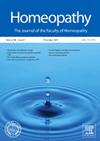Women in Homeopathy.
IF 1.3
4区 医学
Q3 INTEGRATIVE & COMPLEMENTARY MEDICINE
引用次数: 0
Abstract
As stated on our publisher’swebsite, “Morewomen than ever before are choosing to pursue careers in both medicine and medical research; however, a gender gap still exists. According to the UN, women make up 70% of health and social care workers, but only 37% of first authors on medical research articles. At Thieme, we believe the key to closing the gender gap in medicine is to uplift women’s voices”.1 Thieme has therefore created its Women in Medicine collection, “which aims to highlight and celebrate the work and contributions to medicine by female-identifying people from around the world”. Our journal is supporting this important project through its connected Women in Homeopathy collection, available to view via the Authors tab on the homepage. Akin to the format of a Virtual Special Issue, its content is articles published in Homeopathy from 2022 onward that have prominently female authorship. We hope that the new online collection adds encouragement to women to continue in homeopathy research and to submit ever more work to the journal. The contribution by women has been a stand-out feature of Homeopathy for many years, and female authorship is again well represented in this current issue of the journal. Each of the first two papers is a randomised controlled trial (RCT) in humans, on the novel topics of ringworm and hyperuricemia, with inconclusive and positive findings respectively.2,3 An international survey on the uptake and prevalence of the use of repertory software among homeopathy practitioners is the topic of our third article.4 The ever-eclectic nature of homeopathy research is reflected in the remaining papers: an RCT on homeopathic products as a complementary dietary additive for pigs5; an in-vitro experiment on the antimicrobial activity of dynamised essential oil of the medicinal plant Aloysia polystachya6; and the laboratory development of a method to immobilise solvatochromic dyes on cellulose films that will refine the investigation of dye–potency interactions.7 The issue is suitably completed by a clinical case report, from an allfemale group of authors, detailing the effective use of homeopathy to treat a woman with multiple chronic conditions.8顺势疗法中的女性。
本文章由计算机程序翻译,如有差异,请以英文原文为准。
求助全文
约1分钟内获得全文
求助全文
来源期刊

Homeopathy
医学-全科医学与补充医学
CiteScore
3.40
自引率
70.60%
发文量
34
审稿时长
20.1 weeks
期刊介绍:
Homeopathy is an international peer-reviewed journal aimed at improving the fundamental understanding and clinical practice of homeopathy by publishing relevant high-quality original research articles, reviews, and case reports. It also promotes commentary and debate on matters of topical interest in homeopathy.
 求助内容:
求助内容: 应助结果提醒方式:
应助结果提醒方式:


